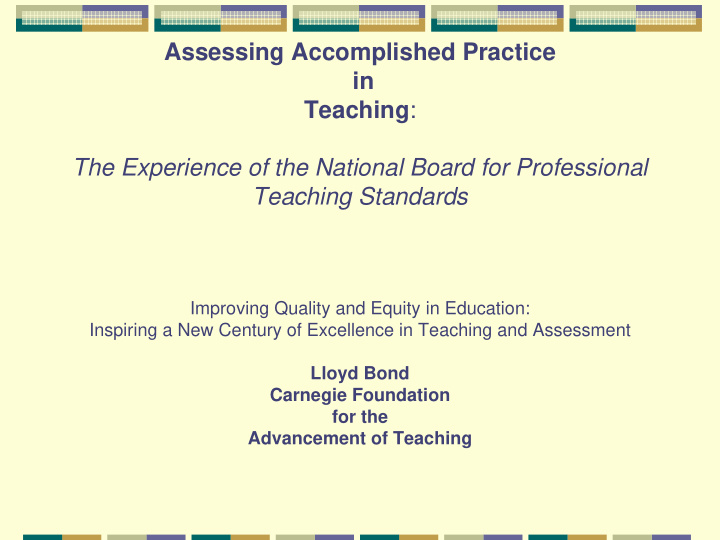



Assessing Accomplished Practice in Teaching : The Experience of the National Board for Professional Teaching Standards Improving Quality and Equity in Education: Inspiring a New Century of Excellence in Teaching and Assessment Lloyd Bond Carnegie Foundation for the Advancement of Teaching
A Little History A Nation at Risk A Nation Prepared Establishing the National Board
The Work of Many People The Visionaries � Lee Shulman, Gary Sykes, Suzanne Wilson, Governor Jim Hunt The Psychometricians � Richard Jaeger, Robert Linn, Lee Cronbach, H. Swaminathan, Ron Hambleton, Ed Haertel, Richard Shavelson, Robert Brennan, Linda Crocker, Barbara Plake, George Engelhart, Ann Harman Assessment Development & Scoring Guru’s � Mari Pearlman, Drew Gitomer, scores of practicing teachers
The Essential Validity Challenge: Being an accomplished teacher vs Demonstrating it in a formal assessment
Five Core Propositions 1. Teachers are committed to students and their learning. 2. Teachers know the subjects they teach and how to teach those subjects to students. 3. Teachers are responsible for managing and monitoring student learning. 4. Teachers think systematically about their practice and learn from experience. 5. Teachers are members of learning communities.
Underlying assessment development principles Tasks should be authentic and therefore complex Tasks should be open-ended, allowing teachers to show their own practice Tasks should provide ample opportunity for analysis and reflection Knowledge of subject matter and knowledge of students should underlie all performances
The Apple Criteria Administratively feasible Professionally acceptable Publicly credible Legally defensible Economically affordable
The assessment architecture C & TE Needs Exc Scienc e Math ELA Gen 11-18 AYA 5-12 2 -6 17+ MC EC EA
Two Important Philosophical Underpinnings Both preparing for the assessment and undergoing the assessment should be “deeply educative” experiences As in other professions, teachers themselves should have primary control over the definitions of quality and “accomplished practice” and the determination of who meets the desired standards of quality
The Assessment Development Process A vision of “accomplished practice” (The Standards Committees) Test blueprint & specifications Development Tryout Development of a scoring rubric Scorer training Setting performance standards
Two Settings The teaching portfolio The assessment Center
The teaching portfolio The paradigmatic in situ assessment Reflect the richness and complexity of teaching in real classrooms Allow considerable latitude in choosing assignments to feature Exhibit actual student work and student feedback Allow (require) reflection and analysis
The Assessment Center On-demand tasks that gauged: � Content Knowledge � Pedagogical Content Knowledge
The psychometric challenges Construct underrepresentation Construct irrelevant variance Scorer training and calibration Adverse impact and bias
Construct underrepresentation Striking the appropriate balance between: � Actual classroom teaching � making developmentally appropriate, challenging, and engaging assignments � Featuring student work � Providing appropriate feedback � Analysis and reflection
Construct irrelevant variance The requirement to write about your work Making the classroom videotape Balancing collegial and administrative support The problem of teaching context Can a teacher (assessor) from Small Town, Idaho faithfully apply a scoring rubric to the performance of a teacher in inner-city Detroit? Can a teacher (assessor) from Derrien, Connecticut be trained to validly assess the performance of a teacher in rural Mississippi?
Scorer Training & Calibration The scoring rubric: a four point scale of “score families” Bias training Scorer calibration
Adverse Impact & Bias An important distinction: Adverse Impact: substantially different rates of certification by subgroups of candidates, without regard to cause Bias: The interpretations and uses of the assessment are not equally valid across the universe of intended applications
The Spencer Studies The Read Across study Teacher and principal nominations Race of assessor x race of candidate interactions The analysis of writing The teaching style study
Construct Validation use of knowledge Monitoring and providing feedback deep representations Testing hypotheses problem solving (reflective practice) improvisation passion for teaching classroom climate respect for students multidimensional challenge representation Deep understanding Sensitivity to context
Future Challenges The classroom of the future: using technology; distance learning; ever increasing student diversity Where the rubber hits the road: Relating performance on the assessment to student learning
Recommend
More recommend